From the threat posed to Mercedes by Red Bull to the near certainty of a safety car, and from radio messages coming under close scrutiny to the potential for thunderstorms, we break down the key themes ahead of the 2014 Formula 1 Singapore Airlines Singapore Grand Prix at Marina Bay…
Mercedes under attack from Red Bull
Lewis Hamilton and Nico Rosberg might have been hoping for a straight fight in Singapore, but the Red Bulls of Daniel Ricciardo and Sebastian Vettel have given themselves a great platform to interrupt the Mercedes duo's private battle for the world championship.
"Coming into the weekend we thought that if we could be within two- or three-tenths of Mercedes then there was a realistic chance to stay with them in the race," said Ricciardo. "We actually ended up closer to them than we thought in qualifying, so that's good. If the start goes okay then it's about trying to be smart and doing something with the strategy.”
The Australian is the only non-Mercedes driver to have won in 2014 and he's proven particularly adept at picking up the pieces when the Silver Arrows falter. He also has little to lose in terms of the championship, which makes him a dangerous proposition for Hamilton and Rosberg.
"If I can get close, then I'll have a go," Ricciardo said menacingly after qualifying. "I haven't been shy doing that this year, but it's difficult on a street circuit."
Passing is indeed difficult at Marina Bay, but there's no doubt that the twisty, low-grip circuit plays to the strengths of the aerodynamically efficient RB10. Vettel has taken the car's predecessors to victory in each of the previous three races in Singapore, so it would be foolish to rule the German out of contention, particularly as he genuinely believed he could have snatched pole, were it not for a couple of mistakes on his final qualifying run.
As ever, much will depend on the start, but we could be set for a four-way race for victory.
The inevitable safety car could play havoc with strategy
According to the old adage, there are only two inevitabilities in life: death and taxes. But just as inevitable, it seems, is a race in Singapore featuring a safety car. There has been at least one safety-car period in every in every Grand Prix run at Marina Bay - nine in total - and that can have a big impact on strategy.
Pirelli have suggested three stops is the best way to go - starting on the supersoft compound, stopping for more supersofts around lap 20 and then again around lap 36, and then finishing on the softs from around lap 51. But as the tyre firm's motorsport director Paul Hembery suggests: "All it takes is the right pace management or a safety car at the right time to make a two-stopper work."
On paper a three-stopper should yield a cumulative race time around 10 seconds quicker than the fastest two-stopper, but as any race strategist will tell you, the best laid plans can go out of the window once the safety car appears…
Alonso poised for podium charge
For much of qualifying it looked like Ferrari might be able to mount a serious challenge for pole position, but in the end Fernando Alonso and Kimi Raikkonen (who suffered a software glitch in Q3) had to settle for fifth and seventh respectively.
But far from being downbeat about being out-qualified by four cars, Alonso - who was fastest in both FP1 and FP3 - was in optimistic mood on Saturday evening.
"This fifth place is a bit different to usual, because the gap to pole is really small," the Spaniard said. "I think the podium is closer than ever, because the level of competitiveness is quite good this weekend."
Alonso can consider himself something of a Marina Bay specialist, having won here in 2008 and in 2010 - the latter victory coming courtesy of a brilliant, race-long defence from the quicker Red Bull of Vettel. Alonso might have to best the German again if he is to break into the top three for only the third time this season, but with the F14 T showing genuine pace - particularly on the supersoft rubber - he is well set to mount an attack on the Singapore podium - the perfect tonic for both him and Ferrari after the disappointment suffered on home soil at Monza.
Radio transmissions to be monitored extremely closely
This race represents something of a step into the unknown for the drivers and teams with new restrictions reducing the amount of information that can be passed from pit wall to driver via radio.
Race engineers are now forbidden from giving their drivers any information relating to driving technique or performance - and that could have a significant effect on the race. Whereas before drivers were advised on things such as eking out tyre life or how best to overtake an opponent, they'll now have to rely primarily on their instincts, experience and skill, and that's bound to suit some drivers more than others.
The FIA has issued a list of messages that must not be transmitted by either radio or pit board, but there are still plenty of grey areas, so it's not inconceivable that some teams could run into trouble.
The governing body’s Formula One race director Charlie Whiting has said that up to eight people will be monitoring radio traffic during the race and that any driver found to have received banned messages could be hit with a sporting penalty from the stewards, such as a five-second stop-go penalty.
Never in F1 history have radio messages been under such scrutiny - it's going to be interesting…
Thunderstorms not out of the question
There has never been a wet event in Singapore's six-race history, but that could change on Sunday if the forecast thunderstorms appear as expected. So far none of the sessions held this weekend has been afflicted by bad weather, but it did rain on both Friday and Saturday, with the latter downpour occurring straight after the end of qualifying and lasting for some time.
The Marina Bay Street Circuit yields very little grip in dry conditions - and the rain after qualifying will have washed away much of the rubber that had been laid down - but it could become positively treacherous if it rains, what with the numerous painted road markings and bumpy surface. It's also worth noting that none of the drivers has raced an F1 car in the rain under floodlights, so if there is a downpour they'll have to quickly get to grips with the unusual visibility - or lack of.
On the plus side, if it does rain, at least it will keep the drivers cool…
Next Up
Related Articles
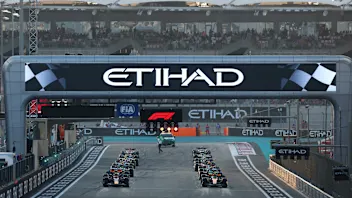 This Week in F110 quiz questions on the Abu Dhabi title decider
This Week in F110 quiz questions on the Abu Dhabi title decider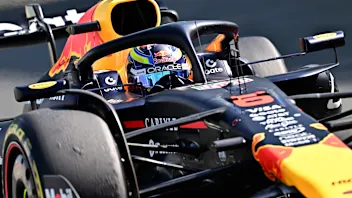 Drivers hit the track for Abu Dhabi post-season test
Drivers hit the track for Abu Dhabi post-season test Beyond The GridToto Wolff and Hywel Thomas on Mercedes’ 2026 prospects
Beyond The GridToto Wolff and Hywel Thomas on Mercedes’ 2026 prospects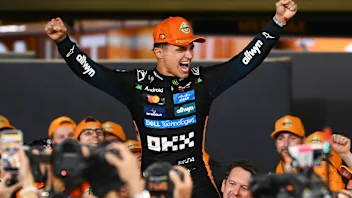 All the key stats from Norris’ title-winning season
All the key stats from Norris’ title-winning season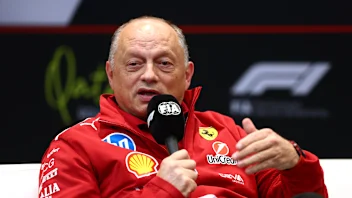 Abu Dhabi 'not a bad weekend' for Ferrari – Vasseur
Abu Dhabi 'not a bad weekend' for Ferrari – Vasseur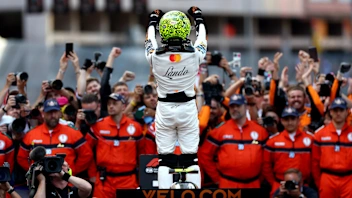 PalmerThe 6 defining moments of Norris’ title-winning season
PalmerThe 6 defining moments of Norris’ title-winning season